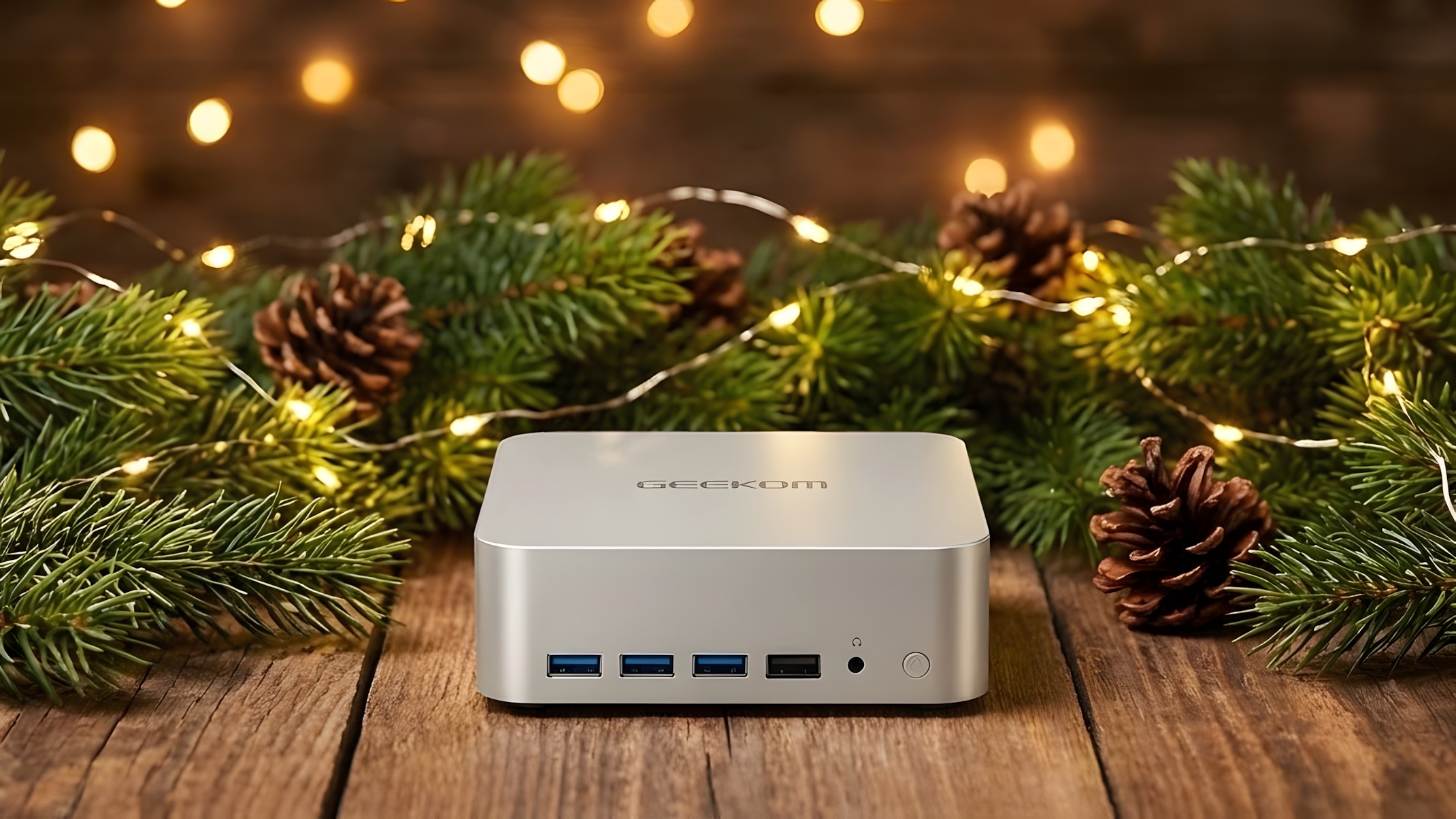Castlevania Puzzle: Encore of the Night - Review
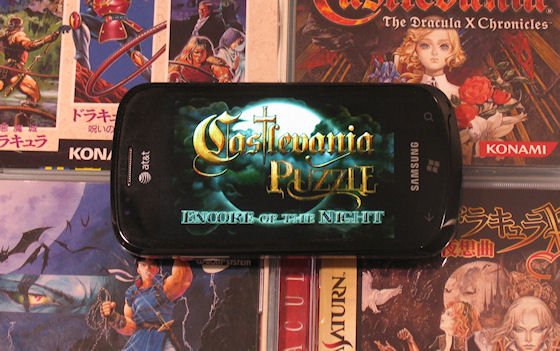
Xbox Live on Windows Phone 7 already has a puzzle RPG game, Namco’s Puzzle Quest 2. But that game is riddled with bugs and really wasn’t optimized for mobile platforms. Thankfully Castlevania Puzzle: Encore of the Night from Konami shows a lot more care in making a quality puzzle RPG. In fact, it may be the best Xbox Live title released for Windows Phone 7 so far.
Castlevania has a long, proud history. The first title was released on the 8-bit Nintendo Entertainment System way back in 1987. Castlevania games tend to be action-platformers; after 1997’s Symphony of the Night, strong RPG elements became standard as well. In adapting the series to mobile platforms, Konami realized that action games don’t usually work well with touch screen controls. Prudently, Encore of the Night replaces the traditional platform jumping and battles with something new to Castlevania: puzzle battles. Role-playing elements haven’t fallen by the wayside, though, resulting in a game that is at once familiar and fresh to series veterans.
Head past the jump for our in-depth review.
Encore to a Symphony
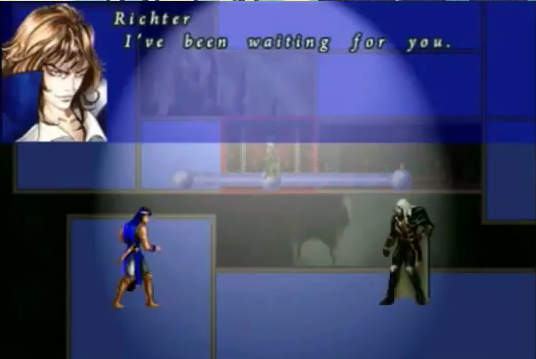
Castlevania Puzzle is not a completely original game (and how few Castlevanias are, if we’re being honest). This WP7 game re-imagines Castlevania: Symphony of the Night, the most-beloved and pivotal title in the series. The exact same story remains: Alucard, the half-human son of Dracula, awakens from hibernation thanks to the reappearance of Dracula’s castle. He encounters Maria Renard, a teenage girl who helped Richter Belmont defeat Dracula once before. Richter, latest in a long line of vampire hunters, entered the castle after it reappeared and hasn’t been seen since. Alucard must unravel the mystery of the haunted castle’s return while trying to help Maria save Richter.
A vast castle
Symphony of the Night is often praised for its vast Castle and Metroid-like exploration. Castlevania Puzzle retains both elements: the entire castle map is present (save for one part I’ll mention later), with dozens of rooms and shortcuts to explore. Like the original SOTN, many pathways won’t be accessible to Alucard until he gains the abilities or relics needed to pass them. Instead of running and jumping from room to room, navigation is accomplished by clicking on the paths that connect each castle room. The player selects a path and Alucard moves there automatically. A hint system insures players will always know where to go. It’s often necessary to backtrack to old areas, but special safe rooms make things easier. Alucard can warp between the safe rooms he has reached, and he can always return instantly to the last one entered as well.
All the latest news, reviews, and guides for Windows and Xbox diehards.
Puzzlin’ battles
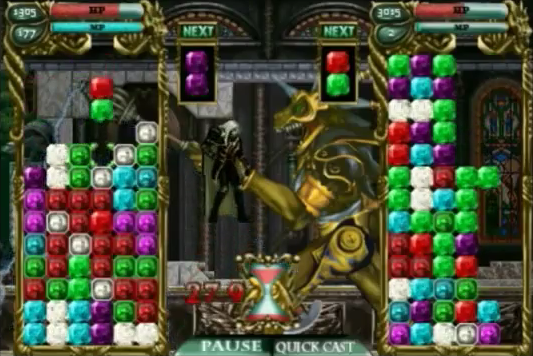
Alucard’s travels are often interrupted by battles. Enemies usually attack the first time he enters a room, and randomly thereafter. Defeating foes earns experience points, money, and sometimes items.
At first glance, Castlevania Puzzle’s battles resemble Capcom’s classic Super Puzzle Fighter II Turbo. The player and enemy’s separate playing fields occupy either side of the screen. Pairs of gems fall from the top of each playing field; these gems disappear when three or more of the same color are matched horizontally or vertically. Making matches and chain reactions causes pieces to fall on the opponent’s field and vice-versa. In the center of the screen, animated versions of the combatants trade blows until the fight ends. There the similarities to Puzzle Fighter end.
Encore of the Night much more closely resembles another puzzle game series, Puyo Pop (AKA Puyo Puyo). Both games have junk pieces – blocks can’t be destroyed until an adjacent set of pieces is cleared. That only reverts the junk blocks to regular colored blocks, which still need to be matched. Stacking blocks wisely and clearing the right ones can result in huge chain reactions that send plenty of junk blocks to the opponent. Wild card blood blocks occasionally appear, too, eliminating whatever junk blocks and pairs of normal blocks they happen to touch.
Hack and slash
Castlevania Puzzle is unlike other falling block puzzle games in that filling the opponent’s field with blocks isn’t the main goal of combat. It certainly helps, lowering their Hit Points and making it harder for them to make matches and fight back. But here, an hourglass located below the fighters flips at regular intervals. At each flip, the combatants trade blows and damage each other’s HP. Damage depends on both parties’ attack and defense stats as well as the number of blocks on their playing field. Because attacking isn’t married directly to filling the enemy’s field, stats make a big difference in the outcome of battles. A well-leveled Alucard can kill lower-level enemies without matching a single set of blocks; powerful bosses will often dispatch careless players in short order as well.
You cast a spell on me
Key to dispatching bosses and tougher enemies is Encore of the Night’s magic and item, or Quick Cast system. Enemies have up to two unique magic spells, while Alucard can select up to four to bring into battle. Spells may be cast at any time as long as MP is sufficient. They hurt, heal, buff, and debuff opponents, just as you would expect in an RPG. Alucard can opt to use some of his Quick Cast slots for items. Once cast, an item falls into the playing field. Destroying an adjacent set of blocks activates the item. Items are a great way to heal without using MP, which you’ll need for offensive spells when fighting later bosses.
Build me up, break me down
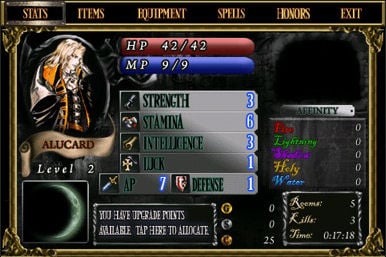
Encore wouldn’t be an RPG without a leveling system, now would it? Upon earning enough XP from felling bad guys and accomplishing other tasks, Alucard levels up. The player then allocates points to a variety of stats:
- Strength: Affect Alucard’s damage to enemies
- Stamina: Regulates Alucard’s HP. The only stat that automatically increases a bit with each level up
- Intelligence: Determines the power of spells and maximum MP
- Luck: Influences the color of blocks that drop and the patterns of junk blocks that drop when either opponent attacks. Lucky definitely matters.
- Fire Affinity : Unlocks spells that do quick damage
- Lighting Affinity : Lightning spells deliver delayed, conditional, and powerful damage
- Shadow Affinity: Utility and buffing spells
- Holy Affinity – Healing and defensive spells
- Water Affinity – Utility and de-buffing spells
Affinities also affect damage dealt and received when the hourglass flips, depending on what colored pieces each combatant’s field holds. Depending on which stats the player develops, Encore’s battles can play out fairly differently. If this all sounds complex (it is), the game’s useful Help section will help make sense of things.
Dress to kill
Customization in Castlevania Puzzle is not limited to leveling up. Equipment also influences stats and block drop percentages. All sorts of weapons and armor are hidden throughout the castle, encouraging thorough exploration. Enemies sometimes drop equipment too. New stuff is usually better outright, but some equipment may suit various character builds better than others. Collecting full equipment sets earns XP bonuses (and eventually the Son of Dracula Achievement).
Vampires live a long time
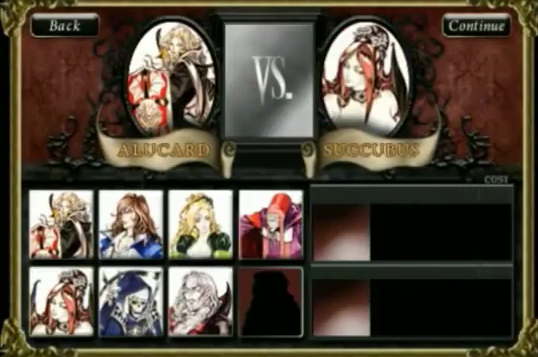
Encore of the Night takes quite a while to beat by mobile gaming standards. Whereas many WP7 games are short, score-based affairs, Encore’s Story Mode took me around 15 hours to beat. Even after all that playtime, I would still have fun going through the game again with a different character build. There is also an Arcade Mode with 8 playable characters. Arcade Mode doesn’t offer much to do besides choosing a pair of characters to mash up in battle and setting the difficulty though. This mode would be way more useful if it supported multi-player (where many a puzzle game shines), but of course Xbox Live games are not allowed that privilege just yet.
A most memorable soundtrack
No Castlevania review would be complete without discussion the sound. Encore of the Night easily boasts the best soundtrack of any Windows Phone 7 game to my ears, period. Michiru Yamane’s haunting Symphony of the Night score is wonderfully reproduced here. Each castle area has its own excellent tune for gamers to enjoy. My only criticism here is that the music switches to a separate battle tune whenever a fight starts. Thus players will only experience brief snippets of the wonderful castle themes unless they stop moving and avoid fights for a while (Encore sadly lacks a sound test). I would have been happier if the regular castle songs kept playing throughout non-boss battles, but it’s a minor complaint.
Achievements
Castlevania Puzzle mainly awards Achievements for exploring Dracula’s castle, collecting sets of cards, and defeating enemies. They tend to come easily enough and encourage player progress. Only two Achievements should provide any trouble: Master Collector (Acquire all 26 playing cards) and Son of Dracula (Complete the 'Son of Dracula' Equipment set). The final card and piece of equipment are guarded by Galamoth, an optional boss and the toughest enemy in the game. Multiple failed attempts at defeating him discouraged me until I finally learned to rely on High Potions for healing while fighting him instead of healing spells. Persistent gamers should be able to net the full 200 GamerScore as I did.
Stumbling blocks
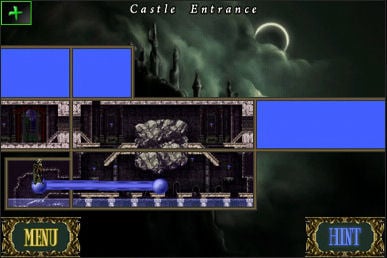
For all my adoration of Encore of the Night, the game is not quite perfect. The leveling system needs some fine tuning. Initially, regular enemies provide enough XP to eventually level Alucard up. After a while though, their XP awards become tiny drops in a Titanic-sized bucket. At that point in the game, felling bosses becomes the only practical method of leveling up, as bosses award instant level increases. If the player doesn’t spend some time grinding against regular enemies early on, it’s possible to reach the last couple of bosses under-leveled and with no realistic way to power up further.
Speaking of those bosses, I found the difficulty for the Galamoth and Dracula battles a little higher than necessary for a phone game, though they would be fine on a console where gamers typically have more time to play and more precise control methods. Yes, there are minor control issues. The game sometimes misinterpreted my gesture for dropping a block instantly (a downward swipe) and simply rotated the block instead, slowing me down in the heat of battle. The controls are fine on the whole though, and their sensitivity can be adjusted in the Options menu.
The game’s menus aren’t the best, either. Selecting things at the title screen takes longer than it should because of an unnecessary flying bat animation. The Character Menu, from which practically every essential non-battle function is performed, is buried beneath another Menu. It really should have its own button on the castle map screen. I also encountered the occasional crash when attempting to view Relics and Cards from the Item screen, but otherwise the game ran extremely well, with super fast load times to boot.
A few of Symphony of the Night’s features didn’t make it into the Encore. The Inverted Castle - which mirrored the original castle, nearly doubling Symphony’s length - has been replaced by the much shorter Demon’s Corridor in this version. Most of the original bosses are present in Encore, except for the classic battle against the trio of heroes from NES Castlevania III (aww). While Symphony’s story scenes remain, they are now told with text only instead of voice acting. The exclusion is unwarranted since voices wouldn’t have increased the game’s file size too terribly; Symphony is only 96 MB on Xbox 360, a size that The Harvest already approaches on WP7. Also missing are a bestiary and a sound test, two staple Castlevania bonus features.
Overall impression
Castlevania Puzzle: Encore of the Night is an exceptional Xbox Live game for Windows Phone 7. Its intricate puzzle battles, immense castle to explore, deep RPG features, and unparalleled soundtrack will appeal to puzzle and RPG fans alike. Castlevania fans will get even more out of the game thanks to nostalgia, but experience with the series is not necessary. Konami may have gotten off to a rocky Windows Phone 7 start with Frogger, but Castlevania Puzzle is a complete turnaround in quality. The game costs $6.99; the high price tag actually feels justified for once.
Buy Castlevania Puzzle: Encore of the Night or delve into the free trial here on the Marketplace.

Paul Acevedo was formerly a Games Editor at Windows Central. A lifelong gamer, he has written about videogames for over 15 years and reviewed over 350 games for our site. Follow him on Twitter @PaulRAcevedo. Don’t hate. Appreciate!
